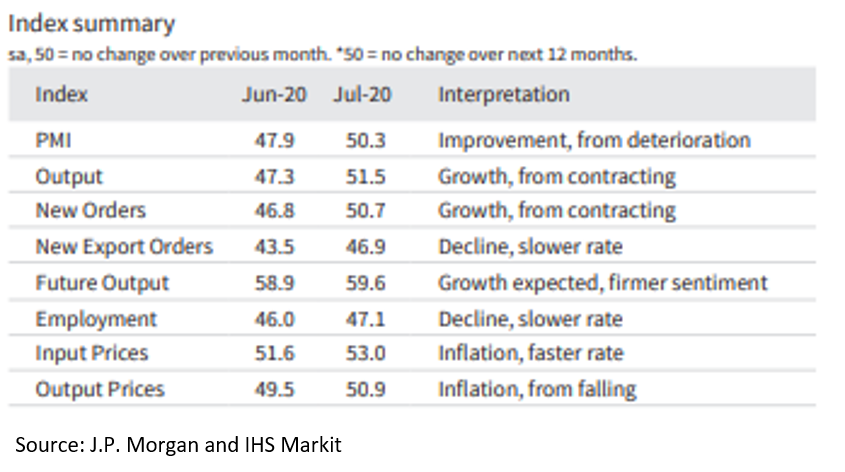Economy

Global Manufacturing Expands, But Remains Challenged
Written by Sandy Williams
August 4, 2020
Global manufacturing finally moved into expansion territory in July, posting 50.3 on the J.P. Morgan Global Manufacturing PMI, up from 47.9 in June. Production and new orders both rose from contraction, posting PMIs of 51.5 and 50.7, respectively. Thirteen of the 27 countries with manufacturing data available posted readings above 50 in July. International trade volumes continue to weaken, however, and average delivery times for vendors lengthened for the 12th successive month. Input purchase prices were higher and passed on in output charges.
“The July PMI indicates that the recovery which began in May continued into mid-summer,” said J.P. Morgan Global Economist Olya Borichevska. “Many of the PMI components reached their pre-pandemic levels for the first time in July including output and new orders. The employment PMI has not recovered, suggesting labor markets will take longer to improve. Still, to fully recoup the losses sustained in the first half of the year will still take some time, especially if the recovery is knocked off course by any future re-tightening of restrictions.”

Manufacturing expanded in the Eurozone for the first time in a year and a half. The IHS Markit PMI rose to 51.8 in July from 47.4 as renewed demand spurred new orders and production. New orders rose at the strongest rate since mid-2018 with demand increasing domestically and abroad. Backlogs declined slightly in July and firms continued to operate below capacity. Purchasing was deferred while manufacturers used existing inventory in production. Unemployment continued to rise as firms cut costs and faced a new wave of coronavirus infections. Business confidence, nevertheless, was at the highest level since January.
“Eurozone factories reported a very positive start to the third quarter, with production growing at the fastest rate for over two years, fueled by an encouraging surge in demand,” said Chris Williamson, chief business economist at IHS Markit. “The next few months’ numbers will therefore be all important in assessing whether the recent uplift in demand can be sustained, helping firms recover lost production and alleviating some of the need for further cost cutting going forward.”
China noted the quickest expansion of production and new orders since January 2011. The Caixin China General Manufacturing PMI rose 1.6 points to 52.8 in July. The increase in demand resulted in a surge in purchasing activity. New orders put pressure on capacity that was reflected in higher backlogs. Elevated prices for raw materials were passed on in output prices. Inventories fell due to higher production rates and supply chain challenges. The decline in export sales softened in July. Employment levels remained weak as companies remained cautious about the pandemic and costs.
Manufacturing output increased in Russia as pandemic restrictions eased last month, but weak new orders led to further cuts in employment. The Manufacturing PMI slid to 48.4 in July from 49.4 in June. Raw material shortages and an unfavorable exchange rate pushed import prices higher. Inventories were depleted as input buying declined and raw material delivery times lengthened. IHS Markit is forecasting a 6.4 percent annual contraction in industrial production for 2020 and a slow recovery to pre-pandemic levels. Despite challenging conditions, confidence was at a six-month high.
Pandemic conditions leading to prolonged business closures have taken a toll on manufacturing in Mexico. The IHS Markit Mexico PMI remained in contraction at 40.4 in July, up from 38.6 in June. Firms continued to cut staffing as production and new orders marched lower. Input costs remained relatively stable, but output prices were cut again in July. Purchasing activity declined and supply side disruption was still prevalent. “One sign of more positive news is that sentiment towards future activity prospects is slowly improving, although it remains negative overall,” said IHS Economist Eliot Kerr.
The manufacturing PMI for Canada jumped to 52.9 in July from 47.9 in June signaling a rebound in production and new orders. The PMI was the highest since January 2019 and the first time above the 50.0 no-change mark in five months. As the economy reopened from COViD-19 shutdowns, production accelerate at its fastest pace in two years. New orders and employment levels both increased moderately. Input buying resumed but stock shortages and transport delays were noted along with higher transportation costs and supplier surcharges. Canadian firms were optimistic about the coming year, but remained concerned about a second wave of the pandemic and the global economic outlook.
The IHS Markit U.S. Manufacturing PMI rose to 50.9 in July, up from 49.8 in June, signaling the first improvement in the PMI since February. New orders and demand increased for the first time in five months, although growth was marginal. Supplier shortages of raw materials pushed input prices higher. Input buying was reduced at the beginning of the third quarter and inventories declined. Employment contraction softened and more firms were optimistic about future business conditions.
“Although indicating the strongest expansion of the manufacturing sector since January, the IHS Markit PMI remains worryingly weak,” said Williamson. “Much of the recent improvement in output appears to be driven merely by factories restarting work rather than reflecting an upswing in demand. Growth of new orders remains lackluster and backlogs of work continue to fall, hinting strongly at the build-up of excess capacity. Many firms and their customers remain cautious in relation to spending in the face of re-imposed lockdowns in some states and worries about further disruptions from the pandemic.
“Encouragingly, business optimism about the year ahead has revived to levels last seen in February, but many see the next few months being a struggle amid the ongoing pandemic, with a more solid-looking recovery not starting in earnest towards the end of the year or even into 2021. Further infection waves could of course derail the recovery, and many firms also cited the presidential elections as a further potential for any recovery to be dampened by heightened political uncertainty.”

Sandy Williams
Read more from Sandy WilliamsLatest in Economy

Steel groups welcome passage of budget bill
Steel trade groups praised the passage of the Big Beautiful Bill (BBB) in Congress on Thursday.

Industry groups praise Senate for passing tax and budget bill
The Steel Manufacturers Association and the American Iron and Steel Institute applauded the tax provisions included in the Senate's tax and budget reconciliation bill.

Chicago PMI dips 0.1 points in June
The Chicago Purchasing Managers Index (PMI) slipped 0.1 points to 40.4 points, in June.

Multi-family pullback drives housing starts to 5-year low in May
US housing starts tumbled in May to a five-year low, according to figures recently released by the US Census Bureau.

Architecture firms still struggling, ABI data shows
Architecture firms reported a modest improvement in billings through May, yet business conditions remained soft, according to the latest Architecture Billings Index (ABI) release from the American Institute of Architects (AIA) and Deltek.
